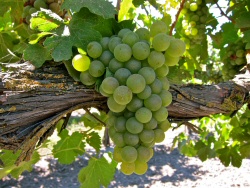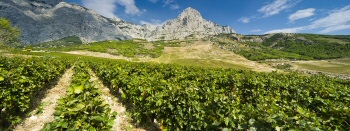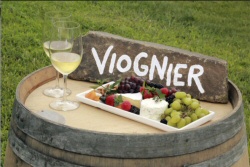|

Viognier is an intriguing grape varietal we’re seeing more of these days. Similar to Chardonnay, Viognier can produce white wines with complex characteristics, proving that not only red wines can have backbone. Viognier wines are also similar to Chardonnay wines in that they are less acidic than many other white wines produced from varietals such as Sauvignon Blanc or Pinot Gris/Grigio.
Viognier’s homeland is considered to be in France, in the Rhône Valley, and it has since stretched across the world, including having significant plantings in places such as California (and specifically in our Central Coast region). However, the origins of the Viognier grape are bit a murky.
Many believe the varietal was actually first grown in what is now the country of Croatia and was introduced to the Rhône by the Romans. One French legend claims that the original vine plantings were meant to be delivered to the Beaujolais region further north, yet the ship navigating the Rhône River was captured on the way by local outlaws near the town of Condrieu. Perhaps nodding credit to the legend, to this day Viognier is the single allowed grape varietal in Rhône appellation of Condrieu, and these wines are considered within France’s top tier of wines.
 Over the centuries, Viognier became known as one of the Rhône’s primary varietals. It’s grown throughout other Rhône appellations where it is often blended with Roussanne, Marsanne, and/or Grenache blanc. The varietal’s popularity has extended outside of the Rhône and is now grown and produced on a large scale in the French growing region of Languedoc. Over the centuries, Viognier became known as one of the Rhône’s primary varietals. It’s grown throughout other Rhône appellations where it is often blended with Roussanne, Marsanne, and/or Grenache blanc. The varietal’s popularity has extended outside of the Rhône and is now grown and produced on a large scale in the French growing region of Languedoc.
The varietal was very nearly lost to the world somewhat recently, with only thirty acres remaining planted in France in the 1960s. And at this time the varietal was not being grown in New World places like California, Washington State, or Australia as it is today. Thankfully, Viognier survived and it is now thriving even in places such as Virginia.
As for the wine made from it, Viognier has the potential to produce full-bodied wines with natural aromatics such as hints of honeysuckle, jasmine, peach, apricot, nectarine, orange blossoms, and pears. Depending on the fruit and style of winemaking, Viognier wines can have strong floral aromas and be reminiscent of Gerwürztraminer wines. Or, they can be drier, more acidic, lighter in texture, and have more citrus flavors.
A winemaker's choice of aging in stainless steel or oak can have impacts on wines produced, just as with Chardonnay. If a Viognier wine is made in a stainless-steel tank, peach and apricot flavors are brought out. If it is made in oak barrels, layers of vanilla and spice will be added.
Although Viognier is nice to sip on its own, it’s also a very food friendly varietal. Chicken and fish dishes are classic choices to pair with Viognier, but other meats with buttery or cream sauces would be safe bets as well. Viognier is also a great choice to pair with shellfish. But always keep in mind the style of Viognier compared to the food. A lighter style Viognier may be a better selection with lighter food dishes and so forth.
 Viognier is also often used as a blending varietal for both white and red wines. Viognier adds aromatics to white Rhône-style blends and is used as a small percentage in Syrah wines to soften tannins. This practice began originally in French Côte-Rôtie wines, but now these wines are made around the world. Viognier is also often used as a blending varietal for both white and red wines. Viognier adds aromatics to white Rhône-style blends and is used as a small percentage in Syrah wines to soften tannins. This practice began originally in French Côte-Rôtie wines, but now these wines are made around the world.
Viognier is notoriously difficult to grow, susceptible to winds, prone to disease, and low-yielding. In the winemaking department, it is known to present steep difficulties for winemakers as they try and balance acidity and alcohol levels, both of which can sabotage a wine if not properly controlled. Long story short, Viognier is definitely not a starting varietal for new growers or winemakers.
Although growing and producing Viognier into wine is complicated, most Viognier wines are not meant for aging. There are some late-harvest wines produced from this varietal which can age well, but most of the time when you see Viognier on its own or in blends, the wines are meant to be opened within a few years.
Our own Central Coast has become a natural home to Viognier. The varietal is grown throughout California, but the Central Coast leads the Viognier charge. Santa Barbara, San Luis Obispo, and Monterey County are growing and producing outstanding Viognier wines. In order to thrive, the varietal needs a climate which is not too hot, or at least it must have some climatic characteristic which cools down the vines and berries. It should not be surprising then to consider how Monterey County’s afternoon winds, especially in summer, are not all that dissimilar from the Rhône’s famed Mistral winds. |


 Over the centuries, Viognier became known as one of the Rhône’s primary varietals. It’s grown throughout other Rhône appellations where it is often blended with Roussanne, Marsanne, and/or Grenache blanc. The varietal’s popularity has extended outside of the Rhône and is now grown and produced on a large scale in the French growing region of Languedoc.
Over the centuries, Viognier became known as one of the Rhône’s primary varietals. It’s grown throughout other Rhône appellations where it is often blended with Roussanne, Marsanne, and/or Grenache blanc. The varietal’s popularity has extended outside of the Rhône and is now grown and produced on a large scale in the French growing region of Languedoc.  Viognier is also often used as a blending varietal for both white and red wines. Viognier adds aromatics to white Rhône-style blends and is used as a small percentage in Syrah wines to soften tannins. This practice began originally in French Côte-Rôtie wines, but now these wines are made around the world.
Viognier is also often used as a blending varietal for both white and red wines. Viognier adds aromatics to white Rhône-style blends and is used as a small percentage in Syrah wines to soften tannins. This practice began originally in French Côte-Rôtie wines, but now these wines are made around the world.